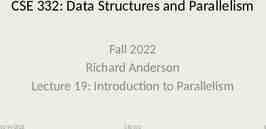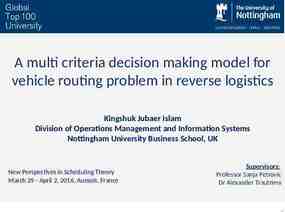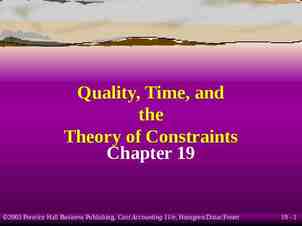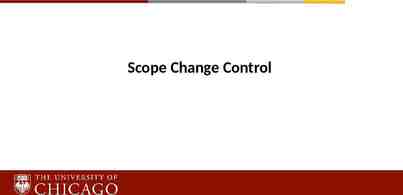KURT LEWIN TIFENIE HARRIS, AUNDREA ROBINSON-BURRIS, KELLY MCELWAIN
18 Slides185.58 KB

KURT LEWIN TIFENIE HARRIS, AUNDREA ROBINSON-BURRIS, KELLY MCELWAIN

Who is Kurt Lewin Jewish psychologist born in Germany (Miner, 2006). Earned Doctorates degree in Psychology from The University of Berlin in 1914 (Miner, 2006). Moved to US in 1933 prior to Hitler movement after impressive visit with Lewis Terman (founder of Stanford-Binet tests) at Stanford University (Miner, 2006). Study of groups and action research after his move to the United States led to his development of Change Theory; his major contribution to nursing (Miner, 2006).

Path to Change Theory Lewin theorized that “behavior is a functional interaction of person and environment” (Miner, 2006). Studied leadership and leadership climates which led to the development of the field of Organizational Behavior and Change Theory (Miner, 2006). Research on group decisions and democratic processes led to the development of theories focusing on the motivation of change (Miner, 2006). Lewin studied group dynamics and field theory which led to the development of Action Research and eventually change theory (Suc, Prokosch & Ganslandt, 2009). Change Theory

Lewin’s Change Theory UNFREEZE CHANGE REFREEZE

UNFREEZING Finding a method of making it possible for people to let go of an old pattern that was counterproductive. The stage where the desire to change occurs. The more transparent and inclusive the process is, the more readily people move through this stage. Kaminski,J. (2011)

CHANGE Change in thoughts, feelings, behavior, or all three that is more productive in some way. New structures and processes are put in place to achieve the desired improvements This is the most time-consuming, costly, yet productive stage. Kaminski, J. (2011)

REFREEZING Establishing the change as a new habit or process. Rewards, support, and champion leadership is important through this stage. The changes are “frozen” in place to ensure that they become part of normal working procedures. Establish supportive mechanisms such as policies, rewards, ongoing support, and a solid orientation for new employees. Kaminski, J. (2011)

KURT LEWIN THEORY HOW THE CHANGE THEORY MOTIVATES NURSING The theory involves an action of planning and fact gathering before proceeding on to the next phase of action. It ensures that all participants are comprehending what is expected of them correctly. Keeps a strong focal point in the area of communication. A great article that regarding how the theory motivated nursing is: http://en.articlesgratuits.com/ article.php/id article 374 Keith, M. (2006) UNFREEZING CHANGE INITIATION ADAPTATION REFREEZING DRIVING FORCES ACCEPTANCE USE RESTRAINING FORCES INCORPORATION EQUILIBRIUM Kaminski, J. (2011)

Action Research and the Successful application of Change Theory to Nursing (Suc, Prokosch and Ganslandt, 2009) This is very similar to the five step nursing process: Assessment Analysis Planning Implementation Evaluation (Chitty and Black, 2011) Assessment Analysis Evaluation planning Successful application of Change Theory requires the use of Action Research after a problem is identified(Suc, Prokosch and Ganslandt, 2009) : Reflection about what you know Planning a strategy for change Acting based upon the planned strategy Observation of the group and the environment after the action has taken place Implementation /http://effective.leadershipdevelopment.edu.au/lewins-4-stage-model/activelearning

Is Change Theory unique to Nursing ? Change Theory can be applied to any field of practice where implementation of change is needed.

Change theory and the Four Global Concepts Human being- There is always a force of resistance to change. “The human factor must be taken into account to achieve acceptance and commitment of all participants” (Suc, Prokosch & Ganslandt, 2009). Environment- The environment can be manipulated to encourage human beings to move towards a change goal. The environment must be evaluated for appropriate change interventions (Suc, Prokosch & Ganslandt, 2009). Health- Unhealthy behaviors and unhealthy environments can be changed if this theory is applied correctly (Suc, Prokosch & Ganslandt, 2009). Nursing – When working with large groups to implement change, this model is ideal when used in conjunction with action research. It has proven useful to nurse managers in the implementation of change and “applicable to conflict situations in the nursing environment” (Suc, Prokosch & Ganslandt, 2009).

What Practice Settings Have Used Change Theory Information Technology- changing to a new data collection system - Management- changing processes to improve efficiency and patient care - Conflict Resolution- changing attitudes and behaviors - Group Processes – Replacing older, familiar products with new products and technology (Suc, Prokosch & Ganslandt, 2009).

Strategies for Unfreezing Workshops Informational bulletins Active participation in the formulation of plan. Continuous feedback from participants in all phases of change. Accountability without fear of punishment for results. (Suc, Prokosch & Ganslandt, 2009).

Conclusion Kurt Lewin’s Change Theory has been an effective tool in organizational behavior modification. Change Theory has been instrumental in implementing change in many difficult groups. Reflect on the needed change and what you already know about it. Collect data about the population, their attitudes and concerns. Plan a course of implementation and Act upon it. Observe the results of implementation and modify the plan based on your results as needed.

Case Study (part 1) The Story You are a nurse manager of a 750 bed nursing facility with 200 nursing care staff. This facility has been in existence for more than 50 years and you have staff with years of service ranging from 1-25 years. Over the past six months there has been a significant increase of patients who have been admitted to the hospital emergently for bowel obstruction. To reduce the incidence of bowel obstruction and reduce the cost of hospitalization you have been assigned to implement the use of a new bowel care monitoring system. The current system has been in place for the entire history of the facility. The survey Interviews and surveys were conducted to recognize the key factors for resistance and key factors to motivate change. 1. All of the direct care nurses with years of service ranging from 10 to 25 years were resistant to the implementation of a new system. Theses nurses accounted for 65 members of the total nursing care staff. 2. Nurses who served in administrative and leadership roles were motivated to implement the change. These nurses accounted for 45 members of the total nursing care staff 3. Nurses who had less than 10 years of service accounted for 110 members of the total nursing care staff and most were neutral about change. 4. There are 13 nursing units in the entire facility. Each one operates differently and fear of a lack of consistency with implementation was expressed. 5. Nurses with 10-25 years of service noted their fear of a less effective system being implemented. 6. There was an expressed fear of disciplinary repercussions for the failure of the new system. 7. All nurses noted their desire to provide quality effective care to all patients. 8. 20 patients in 6 months were hospitalized related to bowel obstruction. 10 cases were fatal from complications of the illness. Write a brief one paragraph summary based on the following exercises and include the questions on slide 16 in your answer. Use the chart on the next slide to identify the factors that need to be addressed for change. What would be your strategy for implementation of change based on Kurt Lewin’s Change Theory? Use part 2 and the questions on slide 16 to help you formulate an answer. Access the following website to help you formulate your answers http:// www.change-management-coach.com/kurt lewin.html

Case Study (part 2) Pro change Rate it Proposed Resist change change Rate it Help participants understand that change is required. Identify the key motivations to change and key factors contributing to resistance of desired change enter your findings into the grid and rate your answers 1-5. (1 being lowest rating and 5 being highest) Measure the motivation for change (pro change), and the factors of resistance. Use the top rated factor of each category as a strategy for implementation of change. There will be one proposed change for the entire assignment. It will not change with each factor. Enter the number of the factor from the survey findings into the grid and rate each one. There may be more than one factor with the same rating in its column. Write a brief paragraph explaining your findings.

Answer these questions in your summary paragraph Who are the key figures to motivate change and why? What are the key factors to motivate change in this scenario?

REFERENCES Chitty, K.K., & Black, B.P. (2011). Professional nursing: Concepts and challenges (6th ed.) Nursing pathway to professionalism. Maryland Heights, MO: Saunders Kaminski, J. (2011). Theory applied to informatics-Lewin’s change theory. CJNI: Canadian Journal of Nursing Informatics, 6 (1). Retrieved from http://cjni.net/journal/?p 1210 Keith, M. (2006). Change theory: The motivation it gives to health care nursing. Retrieved from http://en.articlesgratuits.com/article.php?id article 374 Kelly, T. (2009, April). [Diagram of Lewin’s four stage model]. The Effective Leadership Development Community. Retrieved from http://effective.leadershipdevelopment.edu.au/lewins-4-stage-model/active-learning/ Miner, J. (2006). Organizational behavior 1 : Essential theories of motivation and leadership. Armonk, NY: M.E. Sharp, Inc. Retrieved from http:// 0-site.ebrary.com.libcat.ferris.edu/lib/ferris/docDetail.action?docID 10178132 Suc, J., Prokosch, H. and Ganslandt, T. (2009, May). Applicability of Lewin's change management model in a hospital setting. Methods of Information In Medicine, 48(5), 419-428. doi:http://dx.doi.org/10.3414/ME9235






